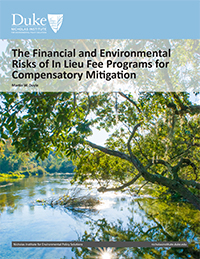This is a review of a sample of In Lieu Fee (ILF) Programs through an analysis of general incentives created by the ILF Program model, and through drawing on a small sample of ILF Programs as case studies. This review focuses on the incentives created by ILF Programs as a mechanism of compensatory mitigation; while other forms of compensatory mitigation—permittee-responsible mitigation and mitigation banking—are not without their problems, there are intrinsic financial and environmental risks that are unique to ILF Programs.
This review is not comprehensive; rather it draws attention to common shortcomings and flaws of ILF programs and notes necessary safeguards based on three Clean Water Act (CWA) ILF Programs and one Endangered Species Act (ESA) ILF Program. The negative characteristics of ILF programs observed in the case studies here may be outliers, single occurrences, or they may be systemic. Some of the characteristics, however, are emergent and systemic because of the incentives that are created through the ILF Program model. Safeguards are needed by regulatory agency rule-making to govern ILF Programs generally. Indeed, many early problems associated with CWA ILF Programs were addressed through the 2008 Mitigation Rule. While the experiences here demonstrate that the 2008 Rule has in fact addressed some challenges of implementing ILF Programs through adaptive management of ILF Programs over the past decade, other experiences documented here demonstrate that because of local-level discretionary decision-making, some problems have persisted, along with problems not addressed in the 2008 Rule.
The insights gained from this limited review also demonstrate the need for a systematic review of ILF Programs across the U.S., particularly (a) consistency of CWA ILF Programs since the implementation of the 2008 Mitigation Rule, and (b) emerging ESA ILF Programs and their divergence from best practice principles present in the 2008 Mitigation Rule.


